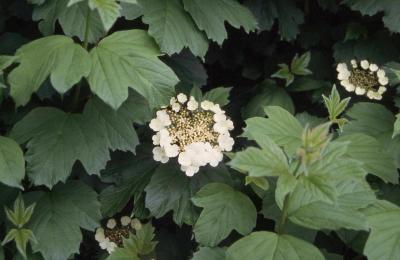Shrub
American Cranberrybush Viburnum
Viburnum trilobum

American Cranberrybush Viburnum flowers and leaves
Features
Lacecap type flower clusters (showy, sterile flowers in a ring around smaller, fertile flowers); flowers white in late spring; bright red fruit in clusters in late summer and autumn (often persisting into winter); summer foliage dark green with a maple-leaf appearance; autumn color is reddish purple.
Culture
Full sun to partial shade; moist, well-drained soil is best, but is tolerant of wet soils; also tolerant of alkaline soils.
Cultivars
- 'Hahs'- 6-8 feet tall, large fruit.
- 'J. N. Select' (Red Wing™)- 6-8 feet tall, good flowering and fruiting, new leaves emerge reddish, excellent red autumn color.
- 'Wentworth'- Heavy fruit production, good fall color.
Mature Height
8-12 Feet
Size
Medium
Mature Width
8-12 Feet
Mature Form
Rounded, usually dense
Native To:
United States (and Illinois)
USDA Hardiness Zone
3 - 7
Soil Conditions
Moist, Well-Drained
Wet
Tolerance
Alkaline Soil
Wet Sites
Wind
Exposure/Light Requirements
Full Sun
Partial Sun/Shade
Uses
Border
Massing
Naturalizing
Screen
Specimen
Foliage Color
Green
Fall Foliage Color
Purple
Red
Pests and Problems
Environmental Damage
Fungal Disease
Additional pests and problems that may affect this plant:
Borers
Additional Notes
Viburnums tend to be multi-season plants with ornamental value throughout a large part of the season.
Related Resources
Home, Yard & Garden Pest Guide
The Home, Yard & Garden Pest Guide (C1391) provides is written for homeowners and other residents and provides nonchemical and current chemical recommendations for controlling pests associated with trees, shrubs, turf, flowers, groundcovers, vegetables, fruit, and houses. In addition, you'll find detailed information about integrated pest management, pesticide safety, and pesticide application and calibration techniques. This publication may be purchased at your local University of Illinois Extension Unit office, or by calling 800-345-6087, or by placing an order online (search for "C1391").
Visit site >>
Illinois Commercial Landscape and Turfgrass Pest Management Handbook
The Illinois Commercial Landscape and Turfgrass Pest Management Handbook (ICLT) is written for professional applicators and provides nonchemical and current chemical recommendations as well as application timing information for all major pests of turf, woody ornamentals and herbaceous ornamentals. This publication may be purchased at your local University of Illinois Extension Unit office, or by calling 800-345-6087, or by placing an order online (search for "ICLT").
Visit site >>
U of IL - Distance Diagnosis through Digital Imaging
A free plant, weed, insect and disease identification service available through your local University of Illinois Extension office. Center Educators or State Specialists review & respond to information and digital images submitted by local Extension office personnel. Some samples may require further examination or culture work (nominal fee involved) at the U of IL Plant Clinic.
Visit site >>
U of IL - Plant Clinic
Services include plant and insect identification, diagnosis of disease, insect, weed and chemical injury (chemical injury on field crops only), nematode assays, and help with nutrient related problems, as well as recommendations involving these diagnoses. Microscopic examinations, laboratory culturing, virus assays, and nematode assays are some of the techniques used in the clinic.
Visit site >>
